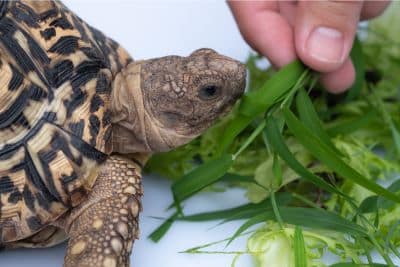All tortoises are not created equal… At least not when it comes to adopting one as a pet. There are dozens of different tortoise species on the planet, many of which make excellent companions. Choosing the right species will ensure both you and your new tortoise can spend many happy years together.
The best pet tortoise breeds tend to be those that are small, active, and adaptable. These species are great for beginners and beloved by more experienced tortoise owners.
In this article, you’ll learn about the different types of tortoises, the most popular species available as pets, and how to choose the best tortoise for your experience level and lifestyle.
- Types of Tortoises
- 10 Varieties of Pet Tortoise Breeds
- 1. Russian Tortoise (Testudo horsfieldii)
- 2. Hermann’s Tortoise (Testudo hermanni)
- 3. Greek Tortoise (Testudo graeca)
- 4. Red-Footed Tortoise (Chelonoidis carbonaria)
- 5. African Spurred Tortoise (Centrochelys sulcata)
- 6. Leopard Tortoise (Stigmochelys pardalis)
- 7. Marginated Tortoise (Testudo marginata)
- 8. Pancake Tortoise (Malacochersus tornieri)
- 9. Egyptian Tortoise (Testudo kleinmanni)
- 10. Indian Star Tortoise (Geochelone elegans)
- Choosing the Right Tortoise
Types of Tortoises
There are currently about 50 known tortoise species. While these species share many things in common—long lifespans, hard protective shells, etc.—each species has also adapted to a unique corner of the world.
What follows is a quick introduction to three major groups of tortoises, including their physical characteristics, the roles they play in their native ecosystems, and how suited they are to life in captivity.
Desert Tortoises
Many tortoise species live in deserts and other arid habitats. Those most commonly known as desert tortoises are endemic to a small region in the North American Southwest.
The Desert Tortoise Council raises awareness for three such species: the Agassiz’s desert tortoise (Gopherus agassizii), the Morafka’s desert tortoise (G. morafkai), and the Goode’s thorn scrub tortoise (G. goodie). These tortoises are primarily found in the Mojave, Sonoran, and Colorado Deserts.
Desert tortoises are fossorial, or burrowing, tortoises. Old tortoise burrows are used by smaller critters for shelter, making these reptiles a vital part of the desert ecosystem.
Desert tortoises are generally legal to keep in captivity, but owners must adhere to strict laws designed to protect the species’ wild populations from issues like poaching and disease. With that said, these tortoises have pretty specific needs and are rarely kept as household pets.
Forest Tortoises
Some forest tortoises belong to the genus Manouria. These tortoises (also known as mountain tortoises) are native to Southeast Asia, where they primarily live in warm, tropical forests at high elevations. The two dominant species include the impressed tortoise (M. impressa) and the Asian forest tortoise (M. emys). The Asian forest tortoise is the largest species of tortoise found in mainland Asia.
If you’re in the United States (or are researching tortoises that live there), then the most common forest tortoise is the gopher tortoise (Gopherus polyphemus). The gopher tortoise is commonly found living in scrubby pine forests throughout the southeastern United States, including much of Florida.
The USDA Forest Service identifies the gopher tortoise as a keystone species—a species of plant or animal that is necessary for a particular ecosystem to exist. For example, an estimated 350 other animal species rely on gopher tortoise burrows to survive storms, wildfires, and predation.
The gopher tortoise is listed as vulnerable (or threatened in the western portion of its native range) and is currently illegal to keep as a pet.
There is one forest tortoise commonly kept as a pet: the red-footed tortoise (Chelonoidis carbonaria). Red-footed tortoises are from South America, where they live in forests and grasslands.
Mediterranean Tortoises
Mediterranean tortoises belong to the fairly large genus Testudo. This genus contains the vast majority of pet tortoise species that are popular today.
Mediterranean tortoises are native to arid regions of Europe, Africa, and the Middle East. (Note that there are a few other species that live in these areas that are not a part of the Testudo genus.)
Many species in Testudo are currently vulnerable or threatened due to changes in their natural habitats. Some species, such as the marginated tortoise (T. marginata), have stable populations. Human intervention (e.g., breeding programs and habitat preservation) continues to make a big difference in the health of these and other wild tortoise species.
Mediterranean tortoises tend to be smaller, more adaptable, and tolerate the dry, mild climates found in most households better than other tortoise genera.
10 Varieties of Pet Tortoise Breeds
Most pet tortoises belong to one of a handful of species. These species make good pets for a variety of reasons, but it is normally because they have relatively simple care needs and can be ethically sourced from captive breeding programs.
The sheer number of pet tortoise breeds means you can choose a species that best aligns with what you want from a new pet.
1. Russian Tortoise (Testudo horsfieldii)

- Other names: Afghanistan tortoise, steppe tortoise, Horsfield’s tortoise, four-toed tortoise
- Conservation Status: Vulnerable
- Lifespan: Russian Tortoises typically live for 40 to 50 years.
- Mature Size: They generally reach a mature size of 6 to 10 inches in shell length.
- Characteristics: These tortoises are known for their broad, high-domed shells and their ability to tolerate temperature extremes.
- Care Difficulty Level: Caring for Russian Tortoises is considered moderate because they require specific dietary and habitat conditions.
- Hibernation: Yes, Russian Tortoises do hibernate, typically undergoing brumation in cooler weather to survive harsh conditions.
- Ideal Temperature Range: The ideal temperature range for a Russian Tortoise’s habitat is between 70 to 95 degrees Fahrenheit (21 to 35 degrees Celsius) during the day, with cooler night temperatures.
The Russian tortoise is one of the (if not the) most popular pet tortoise breeds. It is a Mediterranean tortoise whose native range includes parts of Russia and China. Russian tortoises primarily live on sandy or rocky hillsides and feed on grasses and other plants.
This tortoise is ideal for new owners and is small enough to keep in an indoor enclosure. Wild Russian tortoises hibernate during the cooler months, and it’s normal for a pet tortoise to go dormant for a short period each year.
Did you know? The first Earthlings to ever orbit the moon were two Russian tortoises aboard the spacecraft Zond 5 in 1968. The tortoises safely made it back to Moscow and are likely still alive today!
Are You Starving Your Tortoise?
Save 10% on premium tortoise food and supplements from Tortoise Resource Center on Amazon now using code BUYNOWGET10
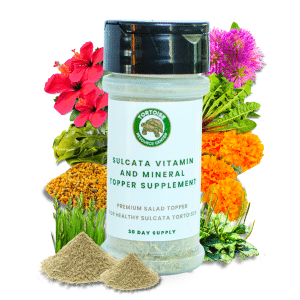
Sulcata Vitamin & Mineral Topper Supplement
30-Day Supply | 2 oz (56 g)
$24.99
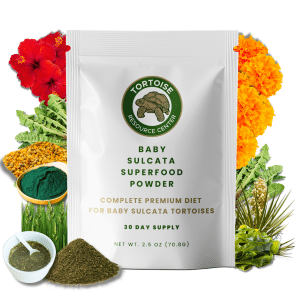
Baby Sulcata Tortoise Superfood Powder
30-Day Supply | 2.5 oz (70.8 g) Bag
$24.99
2. Hermann’s Tortoise (Testudo hermanni)
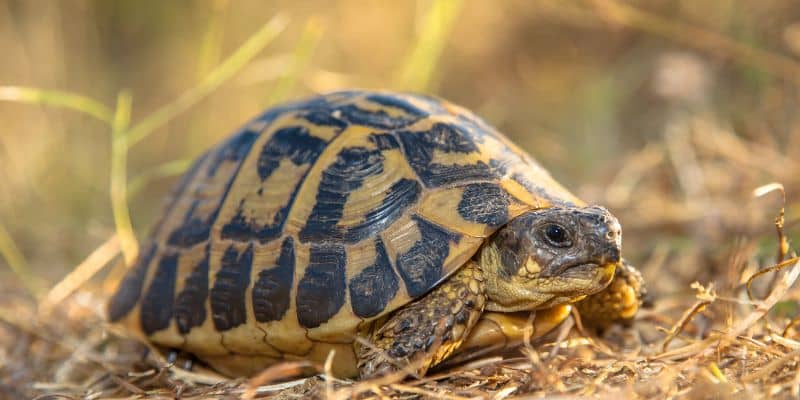
- Other names: Dalmatian tortoise
- Conservation Status: Near threatened
- Mature Size: They typically reach a mature size of 5 to 8 inches in shell length.
- Characteristics: Known for their attractive, domed shells marked with yellow and black patterns, these tortoises are also quite agile and active.
- Care Difficulty Level: The care difficulty level for Hermann’s Tortoises is moderate, as they require a well-maintained habitat and a diet rich in calcium.
- Hibernation: Yes, Hermann’s Tortoises typically hibernate during the winter months, which is crucial for their health and well-being.
- Ideal Temperature Range: The ideal daytime temperature range for Hermann’s Tortoises is between 75 to 85 degrees Fahrenheit (24 to 29 degrees Celsius), with cooler temperatures at night.
The Hermann tortoise is a small and highly adaptable species belonging to the Mediterranean group. This is one of the best tortoises for newbies but is equally adored by experienced owners.
Wild Hermann’s tortoises live in varied habitats, including dry scrublands, grasslands, and forests across parts of southern Europe. When keeping Hermanns’ as pets, they will adapt to life either inside or outdoors in most warm climates.
3. Greek Tortoise (Testudo graeca)
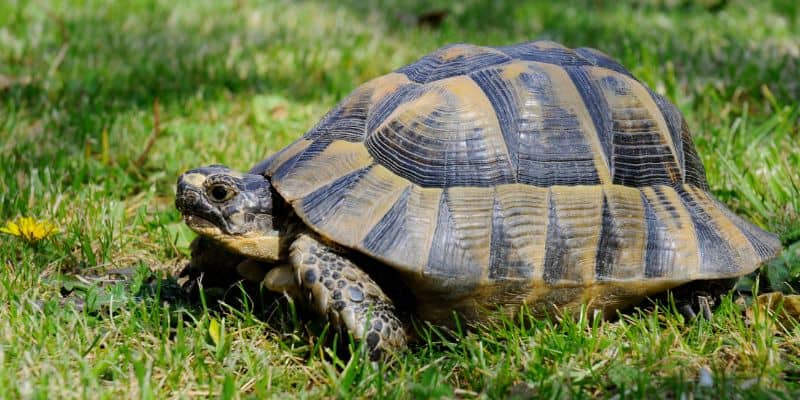
- Other names: Moorish tortoise, spur-thighed tortoise
- Conservation Status: Vulnerable
- Mature Size: They usually reach a mature size of 5 to 8 inches in shell length.
- Characteristics: Greek Tortoises feature thick, high-domed shells with varied patterns and are known for their adaptability to different environments.
- Care Difficulty Level: The care difficulty level for Greek Tortoises is considered moderate, as they require specific environmental and dietary management.
- Hibernation: Yes, Greek Tortoises do hibernate, particularly those from cooler climates, making winter brumation important for their natural cycle.
- Ideal Temperature Range: The ideal temperature range for a Greek Tortoise’s habitat is between 80 to 90 degrees Fahrenheit (27 to 32 degrees Celsius) during the day, with slightly cooler temperatures at night.
The Greek tortoise is very similar in appearance to the more popular Hermann’s tortoise—even long-time owners can have trouble telling the two apart. Both species measure less than 10 inches long and belong to the Mediterranean group.
Greek tortoises are most famous for their remarkably long lifespans. With proper care, a captive tortoise can live to be up to 125 years old!
4. Red-Footed Tortoise (Chelonoidis carbonaria)
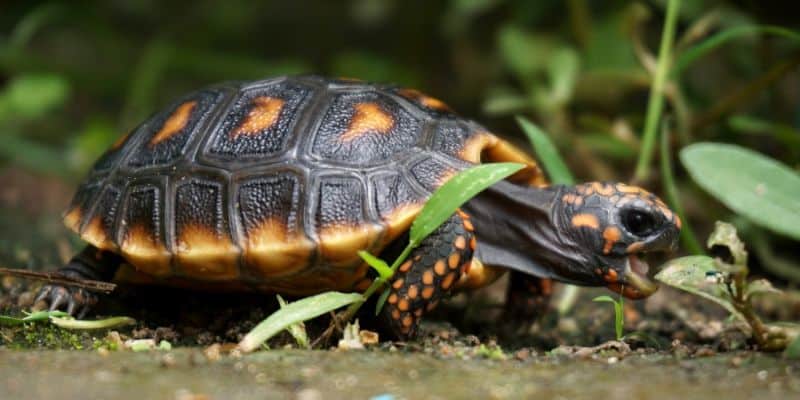
- Other names: Red-legged tortoise, cherry head tortoise
- Conservation Status: Vulnerable
- Mature Size: They typically grow to a size of 10 to 14 inches in shell length.
- Characteristics: Known for their vibrant red or orange markings on their legs and head, these tortoises are quite personable and active.
- Care Difficulty Level: Caring for Red-Footed Tortoises is moderately difficult due to their specific dietary and humidity requirements.
- Hibernation: No, Red-Footed Tortoises do not hibernate, as they originate from warmer climates.
- Ideal Temperature Range: The ideal temperature range for Red-Footed Tortoises is between 75 to 90 degrees Fahrenheit (24 to 32 degrees Celsius), with high humidity levels necessary.
Red-footed tortoises have dark—nearly black—shells and skin, with characteristic red markings commonly seen along their front legs and head. This species is native to Central and South America and is related to the famous tortoises of the Galapagos Islands.
The red-footed tortoise is particularly active and friendly compared to many other pet tortoise breeds. These tortoises will spend much of the day moving and digging around in their enclosure.
While day-to-day care is not dissimilar to most other tortoise breeds, red-footed tortoises need a very specific balance of heat, light, and high humidity to thrive.
5. African Spurred Tortoise (Centrochelys sulcata)
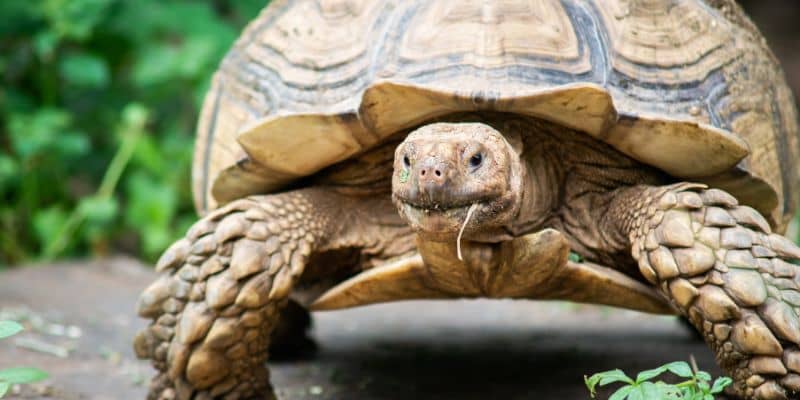
- Other names: Sulcata tortoise
- Conservation Status: Vulnerable
- Lifespan: Sulcata Tortoises can live for 70 years or more with proper care.
- Mature Size: They are one of the largest tortoise species, typically growing to 24 to 30 inches in shell length and weighing up to 100 pounds.
- Characteristics: Known for their large size and sturdy, spiked shells, these tortoises are very hardy and can be quite sociable.
- Care Difficulty Level: Caring for Sulcata Tortoises can be challenging due to their size, dietary, and space requirements.
- Hibernation: No, Sulcata Tortoises do not hibernate; they are native to the Sahara Desert, which requires them to adapt to extreme heat instead.
- Ideal Temperature Range: The ideal temperature range for a Sulcata Tortoise’s habitat is between 80 to 100 degrees Fahrenheit (27 to 38 degrees Celsius), with a basking spot that is slightly hotter.
The African spurred tortoise is the third-largest living tortoise species on Earth and the largest commonly kept as a pet. In the wild, these gentle giants are found in the Sahara Desert and dry scrublands known as the Sahel region.
Keeping an African-spurred tortoise as a pet means constructing a large outdoor enclosure where the tortoise can dig a burrow. The enclosure barrier will need to extend into the ground to prevent the tortoise from burrowing out. African spurred tortoises can tolerate temperatures down to 60°F, so a heated shelter for cooler weather is essential.
6. Leopard Tortoise (Stigmochelys pardalis)

- Conservation status: Least concern
- Lifespan: 80 to 100 years
- Mature Size: They grow to a size of 10 to 18 inches in shell length, making them one of the larger tortoise species.
- Characteristics: These tortoises are recognized for their attractive, leopard-like shell markings and their generally docile nature.
- Care Difficulty Level: The care difficulty level for Leopard Tortoises is moderate, as they require a balanced diet and a spacious environment.
- Hibernation: No, Leopard Tortoises do not hibernate; they are adapted to warm climates and require consistent temperatures year-round.
- Ideal Temperature Range: The ideal temperature range for Leopard Tortoises is between 75 to 85 degrees Fahrenheit (24 to 29 degrees Celsius), with a basking area that is slightly warmer.
The leopard tortoise gets its name from its ornately spotted shell. This species is found in African grasslands and is one of the largest tortoises in the entire world.
Leopard tortoises will thrive in an outdoor enclosure anywhere it stays warm year-round. Note that these tortoises don’t tolerate cool temperatures (below about 60°F), so may need to be brought indoors when temperatures drop.
This is one of the only tortoises that won’t tear up your landscaping! Leopard tortoises are docile wanderers who neither dig nor climb in their home environment.
7. Marginated Tortoise (Testudo marginata)
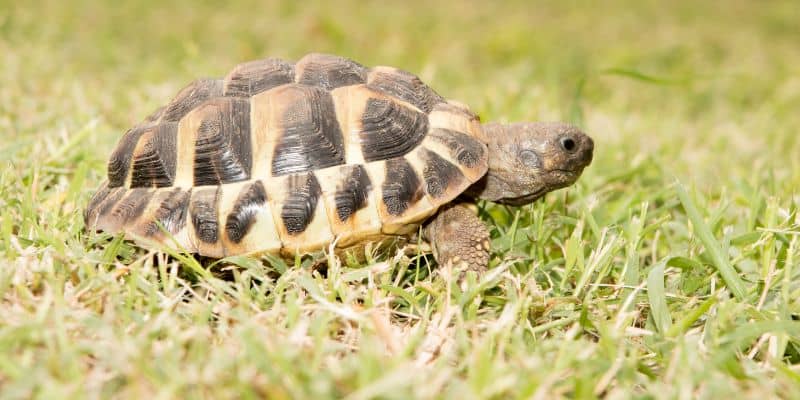
- Conservation status: Least concern
- Mature Size: They typically grow to a size of 12 to 15 inches in shell length.
- Characteristics: Notable for their flared marginal scutes that give them a distinct, “skirted” appearance, these tortoises also have strong, domed shells.
- Care Difficulty Level: Moderate, requiring attention to diet, housing, and temperature management.
- Hibernation: Yes, Marginated Tortoises do hibernate, which is a critical part of their annual cycle to maintain health.
- Ideal Temperature Range: The ideal temperature range is between 70 to 85 degrees Fahrenheit (21 to 29 degrees Celsius) during active months, with cooler temperatures during hibernation periods.
The marginated tortoise is the largest tortoise in the Mediterranean group. Its wild habitat stretches across countries like Greece, Italy, and Albania. These tortoises are most common in rocky, arid habitats such as meadows and scrublands.
To the untrained eye, this species can look a lot like a large Hermann’s tortoise. The easiest way to distinguish one from the other is to look at the back end of the shell. Marginated tortoise shells have ‘flairs’ not seen on other Mediterranean tortoises.
Few people keep marginated tortoises as pets despite the fact they are highly adaptable. Marginated tortoises are much more tolerant of both warm and cold temperatures than most other species.
8. Pancake Tortoise (Malacochersus tornieri)

- Other names: Tornier’s tortoise
- Conservation status: Critically endangered
- Lifespan: 35 years or longer
- Mature Size: They grow to about 6 to 7 inches in length, known for their flat, flexible shells.
- Characteristics: These tortoises are unique for their thin, flat shells that allow them to squeeze into tight rock crevices, a defense against predators.
- Care Difficulty Level: Caring for Pancake Tortoises is considered moderately difficult due to their specific environmental and dietary needs.
- Hibernation: No, Pancake Tortoises do not hibernate; they are native to the warm, rocky regions of East Africa.
- Ideal Temperature Range: The ideal temperature range is between 75 to 85 degrees Fahrenheit (24 to 29 degrees Celsius), with a need for low humidity and ample basking areas.
The Pancake tortoise is quite unique, most notably because of its flattened, flexible shell. These tortoises are native to a small region in Africa—encompassing parts of Kenya, Tanzania, and Zambia—where they live on rocky hillsides.
Pancake tortoises have adapted to fit into the narrow rock crevices characteristic of their native habitat. These crevices provide shelter from predators and the elements.
Something to know about this species is that it is surprisingly fast and agile! Parts of the pancake tortoise’s shell are hollow, making it much lighter than your typical tortoise shell. Pancake tortoises are skilled climbers who are more likely to ‘run away’ from danger than to retreat into their shells.
Pancake tortoises are born with rounded shells just like other tortoises. The shell gradually flattens as the tortoise matures.
9. Egyptian Tortoise (Testudo kleinmanni)

- Other names: Kleinmann’s tortoise, Leith’s tortoise, Negev tortoise
- Conservation status: Critically endangered
- Lifespan: 50 years or longer
- Mature Size: They are one of the smallest tortoise species, reaching a mature size of about 4 to 5 inches in shell length.
- Characteristics: These tortoises have pale, ivory-colored shells with a highly domed shape, which helps reflect sunlight and manage heat in their natural habitat.
- Care Difficulty Level: Caring for Egyptian Tortoises is considered challenging due to their specific needs for temperature, humidity, and diet.
- Hibernation: No, Egyptian Tortoises do not hibernate; they are adapted to the arid conditions of the North African desert.
- Ideal Temperature Range: The ideal temperature range is between 70 to 95 degrees Fahrenheit (21 to 35 degrees Celsius), requiring a controlled environment to mimic desert conditions with very low humidity.
The Egyptian tortoise is not the smallest tortoise in the world (that title goes to the speckled tortoise or Homopus signatus), but it is the smallest species available as a pet. Male Egyptian tortoises grow no more than 4 inches long. The females can reach comparatively longer lengths of 5 to 6 inches.
This is another Mediterranean tortoise with a native range that covers parts of Egypt, Libya, and Israel. There are very few Egyptian tortoises remaining in the wild. While you can source this species from an ethical captive breeder, Egyptian tortoises reproduce quite slowly and, as a result, fetch a hefty price.
10. Indian Star Tortoise (Geochelone elegans)

- Other names: Star tortoise
- Conservation status: Vulnerable
- Lifespan: Up to 80 years
- Mature Size: They typically reach a size of 7 to 12 inches in shell length.
- Characteristics: Known for their stunning star-like patterns on their shells, these tortoises are highly prized for their appearance but are also very sensitive to environmental changes.
- Care Difficulty Level: Caring for Indian Star Tortoises is considered challenging due to their specific dietary and climatic requirements.
- Hibernation: No, Indian Star Tortoises do not hibernate; they originate from warm, humid regions in India and Sri Lanka.
- Ideal Temperature Range: The ideal temperature range is between 80 to 90 degrees Fahrenheit (27 to 32 degrees Celsius), with high humidity levels essential for their well-being.
It’s easy to understand why the Indian star tortoise is so beloved. No other species—not even the leopard tortoise—truly competes with its ornately patterned shell. Sadly, this tortoise is subject to illegal trading due to its popularity.
Indian star tortoises are native to dry habitats across India, Pakistan, and Sri Lanka. These areas also experience a monsoon season every year.
While very pretty, the Indian star tortoise is not a beginner-friendly pet and requires specific care to stay healthy and live a long life. This small tortoise is shy and doesn’t like to be handled by its owners.
Choosing the Right Tortoise
Adopting a new pet is not just about what you want. The right pet is one whose needs align with your lifestyle, including things like your day-to-day schedule and living situation.
This section covers just a few of the most important factors to consider before settling on a type of pet tortoise. Of course, you should do as much research as possible before bringing your new friend home.
Lifespan
Tortoises can live for a very, very long time. While any pet is a serious investment, remember that adopting a tortoise is a commitment that often lasts several decades.
Tortoises will sometimes outlive their owners. What will happen to your beloved pet if you are no longer able to care for it? Will it get passed down to a younger family member? Or will it need to go to a rescue organization? This is something you need to consider and plan for if there’s a good chance your new tortoise will outlive you.
Size
Smaller tortoises typically make better house pets (though this isn’t the only factor that determines whether a tortoise should live indoors!). They need less space—but maybe more than you think—and are generally easier to manage.
It’s not just about how much space your tortoise will take up. You also need to think about how heavy your tortoise will get. There may be times when you need to lift your tortoise—e.g., to take it to the vet. If you choose a breed of tortoise you can’t easily lift and carry on your own; you need to make extra plans for things like routine maintenance and emergencies.
Another thing you might not have thought about is the other people and pets living in your home. While your tortoise should always be in a safe spot where it can’t be disturbed, accidents do happen. A smaller tortoise is naturally more vulnerable to children or animals (including wildlife, if your tortoise lives outdoors) who may not know any better.
Climate Needs
Most tortoises prefer life outside. If you live somewhere warm enough to keep a tortoise happy and healthy, you should definitely consider an outdoor enclosure for all or at least part of the year.
The best indoor tortoises are those that enjoy drier climates—believe it or not, the average home is more akin to a desert than a rainforest! All tortoises need consistent warmth, whether from a heat lamp or the sun itself.
Even if you live somewhere a tortoise can live outdoors, there may be times when the weather turns and you need to bring your pet inside.
Diet
Tortoises don’t live on kibble. Adopting a tortoise often means time spent prepping and serving up fresh produce every day. You also need to provide clean water and, depending on your tortoise’s dietary needs, supplementary vitamins and minerals to keep your pet healthy.
Conservation Concerns
Any tortoise kept as a pet should be sourced ethically and sustainably. A captive-bred tortoise is always best.
If you live somewhere with a native tortoise population, there may be extra steps you should take regarding things like waste disposal to protect those tortoises from things like disease. Do a little bit of research about any wild tortoises that may be living in your region and don’t hesitate to ask questions of your local ecological organizations. They are always happy to help!
Keeping a tortoise as a pet can be fulfilling, but there are some key considerations before you commit. First, make sure it’s legal to own a tortoise in your area, and that you can source it ethically. Then, consider their longevity, where you’d house them (depending on the regional climate) and if you have enough space to accommodate an enclosure. Finally, think of the long term costs including habitat setup, food, heating, and vet care.
Citations
- Desert Tortoise Council – Desert Tortoises
- USDA Forest Service – Saving the gopher tortoise
- NASA – Zond 5 spacecraft
- Smithsonian’s National Zoo – Red-footed tortoise
- Turtle Survival Alliance – Pancake tortoise
- Testudo Kleinmanni – Hatem Moushir CC by 4.0


